Roofing Companies Giffnock
Find Roofing Company in Giffnock
Receive multiple Roofing Contractor quotes for your project today! Compare profiles, reviews, accreditations, portfolio, etc... and choose the best deal.
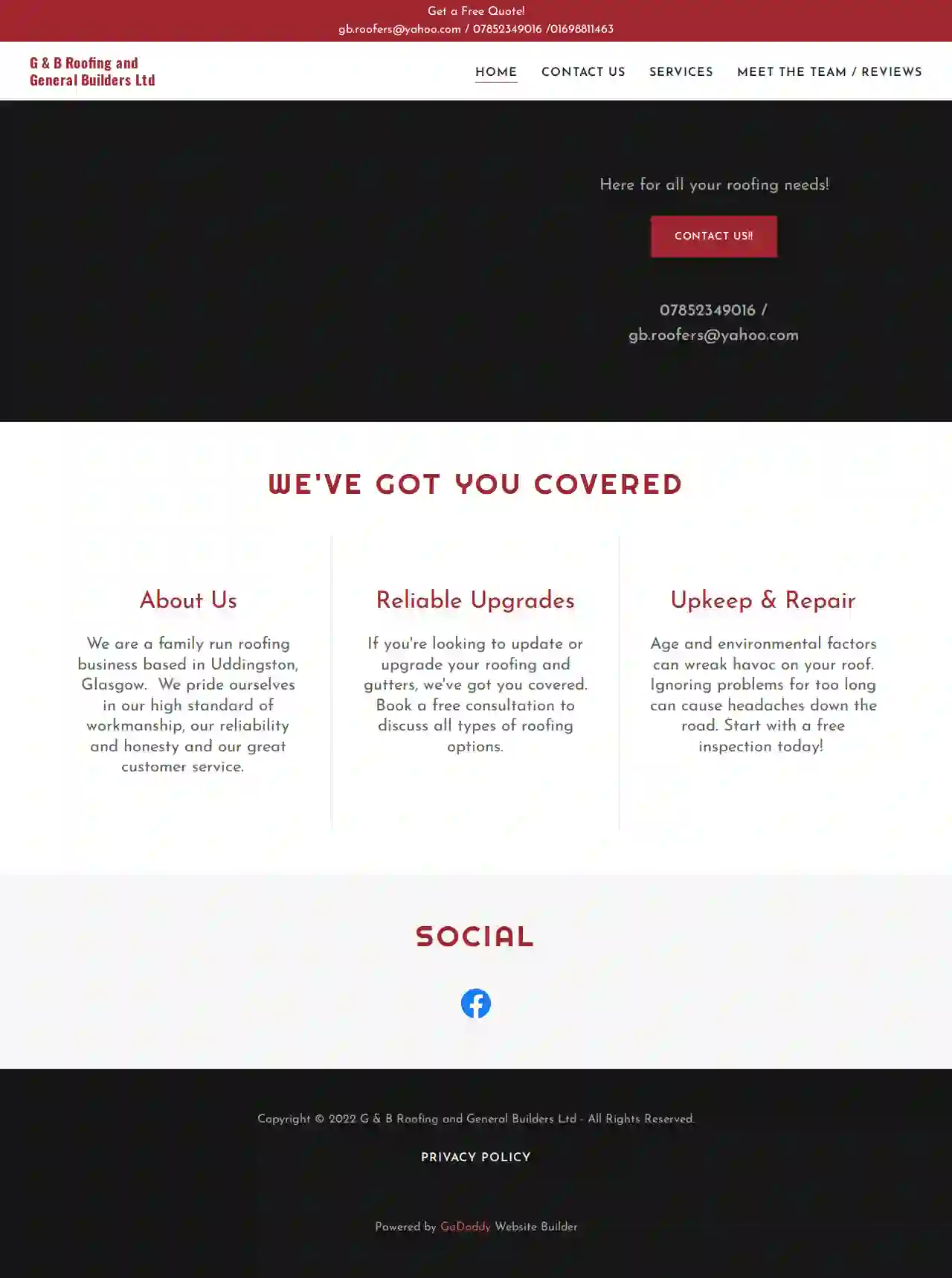
G & B Roofing and General Builders
59 reviews37 Cowan Wynd, Uddingston, G71 6TP, GBG & B Roofing and General Builders Ltd is a family-run roofing business based in Uddingston, Glasgow. We pride ourselves on our high standard of workmanship, reliability, honesty, and excellent customer service. Joseph, with 17 years of experience in the roofing and general building trade, leads the business. We're not just roofers; we can also repair any damage caused by a leaking roof, ensuring a complete solution for your needs.
- Services
- Why Us?
- Accreditations
- Our Team
- Gallery
Get Quote
S McLeavy Property Maintenance
59 reviewsEast Rogerton Farm, Market Hill Road, East Kilbride, G74 4NX, GBMcLeavy Roofers is a reputable, professional, and affordable roofing firm in the East Kilbride, Glasgow, and Lanarkshire area. With over 50 years of experience, we specialize in a range of roofing services, including flat roofing, roughcasting, and fascia and soffit installation. Our team is fully insured, and we guarantee all our work. We pride ourselves on our professionalism, reliability, and quality craftsmanship. Whether you need roofing repairs, roof installation, or PVC roof lining, we're the right people for the job. Contact us today to get a quote.
- Services
- Why Us?
- Testimonials
- Gallery
Get Quote
Rooflinings & Cladding Ltd
52 reviewsCollege Milton, East Kilbride, 5 Springburn Place, G74 5NU, GBWe are an independent roofing company based in East Kilbride, specialising in industrial roofing & cladding. We have been established for over 15 years, which means we have a wealth of experience in the industry. We pride ourselves on adhering to a high standard of workmanship while maintaining our excellent safety record. We offer a range of roofing services including new construction, re-roofing, retrofit over roofing, cladding and maintenance work. We also repair, reline, or replace defective boundary wall / valley gutters and rainwater pipes. We operate throughout Scotland and specialise in industrial roofing and cladding. We also offer consultancy-based services including Site Surveys and Health & Safety reports.
- Services
- Why Us?
- Gallery
Get Quote
Ultimate flat roofing Ltd
57 reviews10 Campsie Road, East Kilbride, G75 9GE, GBThe Ultimate flat roofing company is based in East Kilbride near Glasgow, specializing in Fibreglass and Cold Liquid applied roofing systems. We are approved installers of Topseal the number one glassfibre system on the market and LRS the market leader in cold liquid applied roofing systems. We specialize in commercial as well as domestic contracts. Topseal is the ultimate fibreglass flat roofing system suitable for both domestic and commercial works. They continue to innovate and have recently launched a ground breaking roof system. This flat roofing system has secured BBA certification and is suitable for refurbishments and new builds. check out https://www.youtube.com/watch?time_continue=16&v=z_gc3CcbGFI , LRS is a market leader in liquid waterproofing whether it be a flat roof, metal roof, Asbestos roof, Gutters, walkways and car parks they have products specifically designed for each of these applications. They are also BBA approved and members of LRWA the liquid roofing and waterproofing association. Individualized Roofing OptionsWe will provide you with a full consultation to explain all of your available options so that you can choose the roofing plan that’s right for your home or business. We will work with you and adhere to your personal needs. Why we at Ultimate flat roofing use topseal. Topseal is the ultimate BBA Certified fibreglass flat roofing system. Topseal GRP (also known as fibreglass) roofing systems are installed exclusively by fully trained and approved installers and supplied with a 20 - 40 year product and workmanship guarantee with the back-up of a full customer service, technical support and quality control team. Here are just a few of the reasons why Topseal is the ultimate roofing system: 20-40 year product & workmanship guarantee with an optional insolvency guarantee against workmanship. Proven performance with over a million square metres fitted over the last 20 years and still going strong! Versatile and flexible for new build, replacement roofs, listed or iconic buildings. Only fitted by trained and Topseal approved installation teams UK wide. Environmentally sustainable by design and safe to install. No heat required. Rated A/A+ in the generic BRE Green Guide. Fire Retardant and completely UV resistant Over 1,000 different combinations of colours, and specialist finishes available. Why we at Ultimate use LRS waterproofing systems. Since 2004 they have been leaders in providing high performance waterproofing solutions for the building and construction industry. They have various products that are each designed to give maximum protection and be long lasting. Guarantees are avaliable from standard 10 years to there PRO range of products that give a 20 year guarantee. So whether you have a 10,000 sqr mtr roof or a 20 sqr mtr roof that is starting to need attention we are able to offer our clients solutions that when applied will be long lasting. Just get in contact for your no obligation quote.Customer Satisfaction GuaranteedWe strive to save you both time and money by combining our use of roofing knowledge, the highest quality products and equipment, and our dedication to delivering exceptional service. We will not leave the job until it is finished and you are fully satisfied.
- Services
- Why Us?
- Accreditations
- Our Team
- Testimonials
- Gallery
Get Quote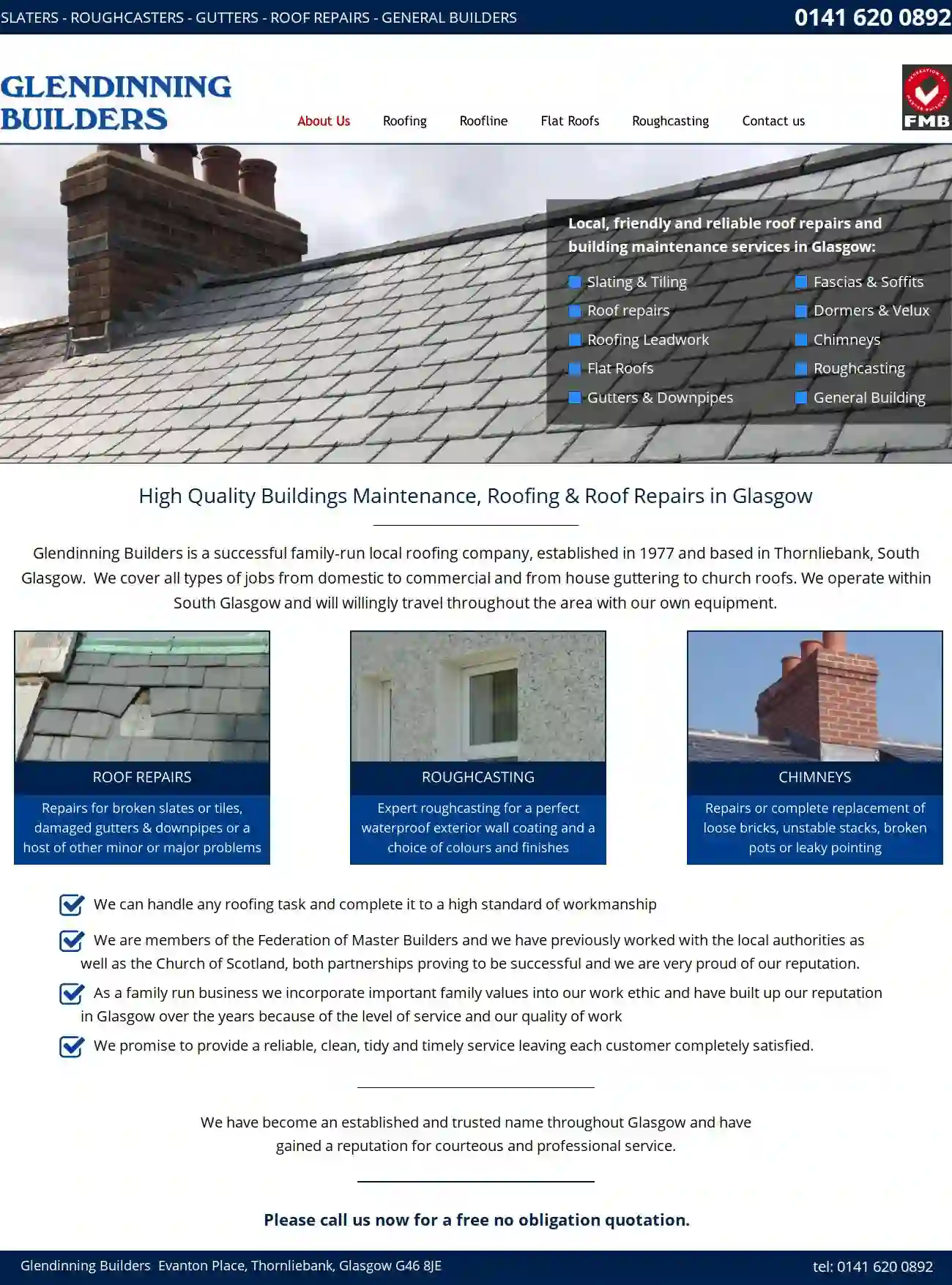
Glendinning Builders
4.99 reviewsThornliebank, Evanton Place, Glasgow, G46 8JE, GBGlendinning Builders is a successful family-run local roofing company, established in 1977 and based in Thornliebank, South Glasgow. We cover all types of jobs from domestic to commercial and from house guttering to church roofs. We operate within South Glasgow and will willingly travel throughout the area with our own equipment. We can handle any roofing task and complete it to a high standard of workmanship. We are members of the Federation of Master Builders and we have previously worked with the local authorities as well as the Church of Scotland, both partnerships proving to be successful and we are very proud of our reputation. As a family run business we incorporate important family values into our work ethic and have built up our reputation in Glasgow over the years because of the level of service and our quality of work. We promise to provide a reliable, clean, tidy and timely service leaving each customer completely satisfied. We have become an established and trusted name throughout Glasgow and have gained a reputation for courteous and professional service.
- Services
- Why Us?
- Accreditations
- Gallery
Get Quote
Strathclyde Domestic Roofing
516 reviews4/1 91 Mitchell St, Glasgow, G1 3LN, GBStrathclyde Domestic Roofing has been a trusted option for 20 years. Our unwavering expertise and unmatched commitment to roof replacement and installation make us the number one choice in Glasgow. Rest easy knowing that our market-leading 20-year insurance backed guarantee ensures unbeatable quality for your peace of mind. We understand the importance of a strong and reliable roof to protect your home and loved ones, which is why we only use the highest quality materials and techniques in our work. At Strathclyde Domestic Roofing, customer satisfaction is our top priority. We strive to provide excellent service from start to finish, ensuring that your roof installation or repair is completed efficiently and to the highest standards. Our friendly and professional team is always available to answer any questions you may have and provide guidance on the best roofing solutions for your home. Don't wait until it's too late to address your roofing needs. Contact us today for a free quote on roof maintenance and experience the unmatched promise of quality and reliability that Strathclyde Domestic Roofing has been delivering for over 20 years. Trust the best roofing contractors in Glasgow to keep your home safe and secure for years to come.
- Services
- Why Us?
- Accreditations
- Our Team
- Testimonials
- Gallery
Get Quote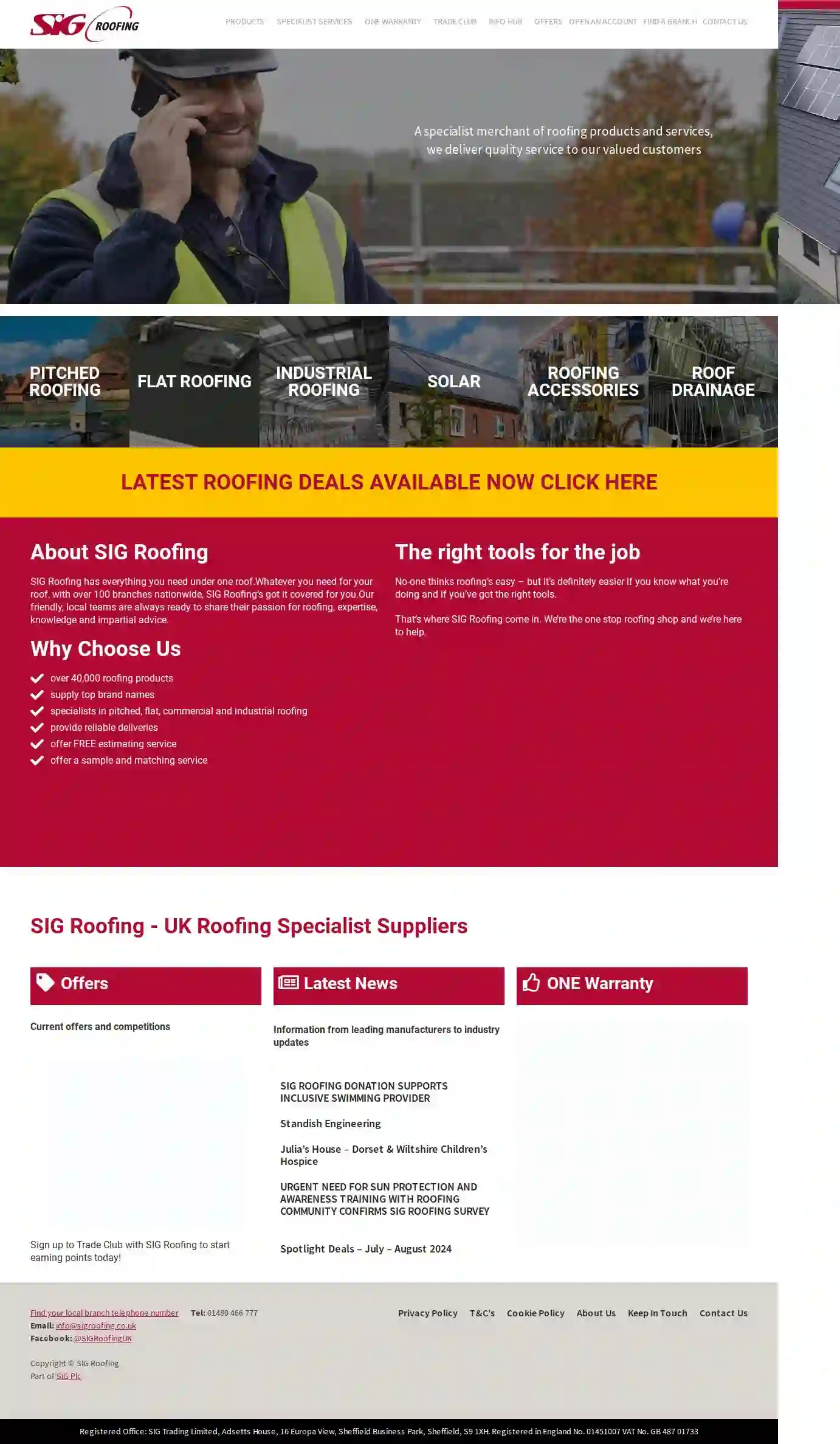
SIG Roofing Linwood
4.526 reviewsGlasgow, GBSIG Roofing is a specialist merchant of roofing products and services, delivering quality service to our valued customers. Established for over 40 years – with branches throughout the UK from Inverness to Plymouth. We have everything you need under one roof. Whatever you need for your roof, with over 100 branches nationwide, SIG Roofing’s got it covered for you. Our friendly, local teams are always ready to share their passion for roofing, expertise, knowledge and impartial advice.
- Services
- Why Us?
- Gallery
Get Quote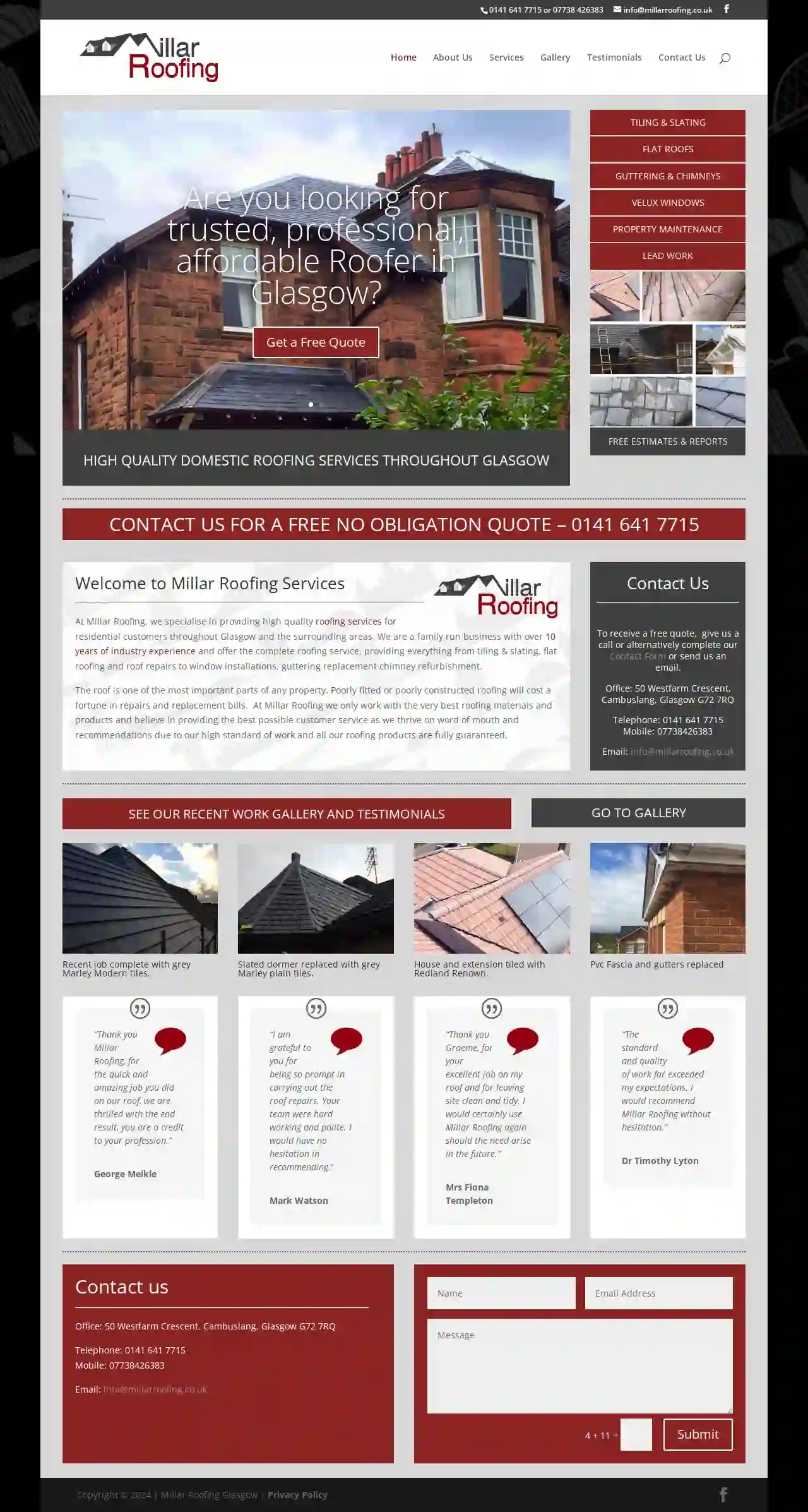
Millar Roofing
50 Westfarm Crescent, Cambuslang, G72 7RQ, GBAt Millar Roofing, we specialise in providing high quality roofing services for residential customers throughout Glasgow and the surrounding areas. We are a family run business with over 10 years of industry experience and offer the complete roofing service, providing everything from tiling & slating, flat roofing and roof repairs to window installations, guttering replacement chimney refurbishment. The roof is one of the most important parts of any property. Poorly fitted or poorly constructed roofing will cost a fortune in repairs and replacement bills. At Millar Roofing we only work with the very best roofing materials and products and believe in providing the best possible customer service as we thrive on word of mouth and recommendations due to our high standard of work and all our roofing products are fully guaranteed. Contact Us To receive a free quote, give us a call or alternatively complete our Contact Form or send us an email. Office: 50 Westfarm Crescent, Cambuslang, Glasgow G72 7RQ Telephone: 0141 641 7715 Mobile: 07738426383 Email: [email protected]
- Services
- Why Us?
- Our Team
- Testimonials
- Gallery
Get Quote
K & G Roofing
Unit 6C Woodhead Road, Glasgow, G69 9HZ, GBK&G Roofing specialise in working at height on Glasgow tenement roofs. We offer a full range of services to private owners and housing associations, including routine maintenance, survey reports, chimney repair and removal, re-roofing. We were established in 1996 and since then have grown steadily through repeat commissions and personal recommendations. We provide roofing services throughout Glasgow, specialising in tenements and working at height: New roofs and repair and maintenance of existing slate and tiled roofs. Replacement, repairs and maintenance of all associated works to roofs – woodwork, gutters / downpipes, render, roof lights, vents and flue vents. Inspection, surveys and cyclical maintenance. Insurance repairs. Glasgow roofing K&G Roofing work throughout Glasgow, providing roofing services to many different house types but specialising in tiled or slated tenement and high roofs.
- Services
- Why Us?
- Our Team
- Testimonials
- Gallery
Get Quote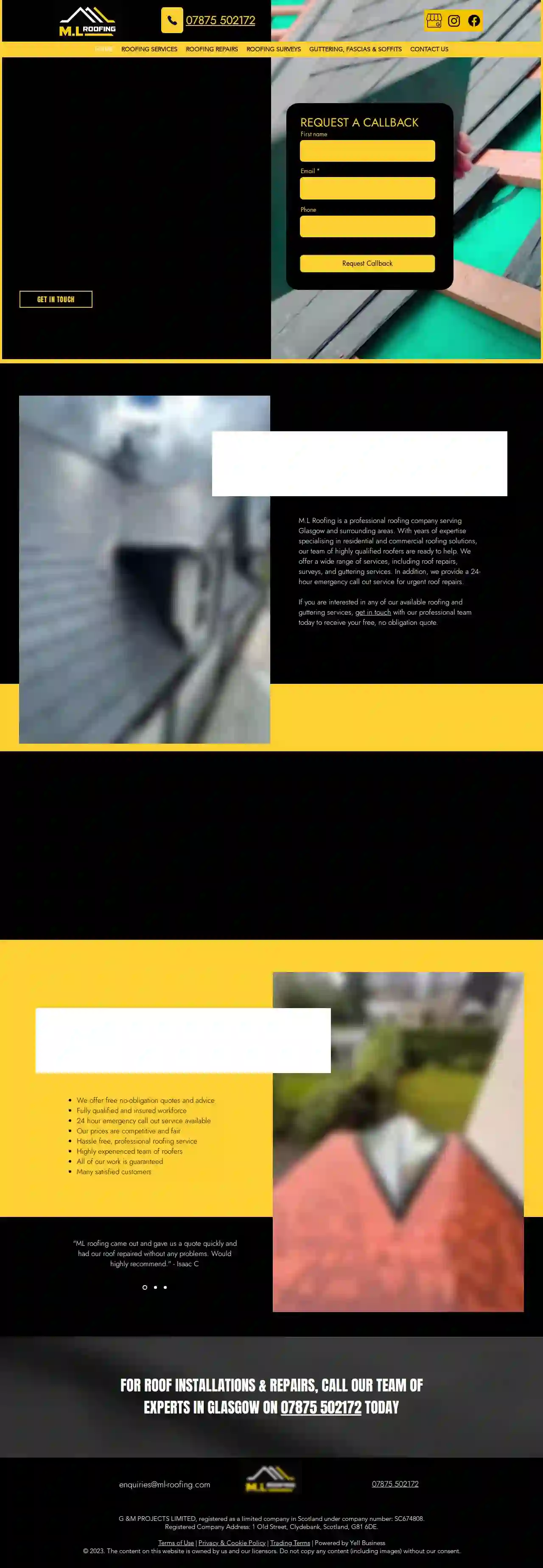
ML Roofing
4.878 reviews1 Old Street, Clydebank, GBM.L Roofing is a professional roofing company serving Glasgow and surrounding areas. With years of expertise specialising in residential and commercial roofing solutions, our team of highly qualified roofers are ready to help. We offer a wide range of services, including roof repairs, surveys, and guttering services. In addition, we provide a 24-hour emergency call out service for urgent roof repairs. We use only high quality materials and pride ourselves on carrying out all work to the highest of standards. If you are interested in any of our available roofing and guttering services, get in touch with our professional team today to receive your free, no obligation quote.
- Services
- Why Us?
- Testimonials
- Gallery
Get Quote
Over 12,314+ Roofing Contractors on our directory
Our roofing contractors operate in Giffnock and surrounding areas!
Roofyng.co.uk has curated and vetted the Best Roofing Companies in and around Giffnock. Find a reliable business today.
Frequently Asked Questions About Roofing Companies
- Safety First: Avoid going onto the roof during a storm, as it's dangerous.
- Document the Damage: Take photos and videos of the damage for insurance purposes.
- Contact Your Insurance Company: Report the damage to your insurance company as soon as possible to initiate a claim.
- Temporary Repairs: If safe, address any immediate leaks using buckets or tarps to minimize further damage.
- Contact a Roofing Contractor: After the storm, have a qualified roofing contractor inspect the roof and provide a repair estimate.
- Listed Buildings: Buildings with historical or architectural significance.
- Conservation Areas: Areas with special architectural or historical character.
- Changes to Roof Design: If you're making significant alterations to the roof's design, such as adding a dormer window or changing the pitch.
- Leaks or Water Stains: Water stains on ceilings or walls, dripping water, or dampness in the attic.
- Missing, Cracked, or Curled Shingles: Inspect for damaged or missing shingles, especially after a storm.
- Damaged Flashing: Look for rust, corrosion, or gaps in flashing around chimneys, vents, or skylights.
- Sagging or Uneven Rooflines: A sagging roof could indicate structural problems.
- Granule Loss: Excessive granules in gutters suggest aging asphalt shingles.
- Moss or Algae Growth: Can trap moisture and damage roofing materials.
- Sagging or Pulling Away: Gutters that are sagging, pulling away from the house, or visibly damaged need repairs or replacement.
- Overflowing Water: If water overflows during rain, it indicates clogs or inadequate drainage.
- Visible Debris: Leaves, twigs, and other debris accumulated in the gutters obstruct water flow.
- Water Damage: Water stains or damage to siding or foundation near the gutters suggest overflow.
- Plant Growth: Plants or moss growing in the gutters indicate standing water and the need for cleaning.
What should I do if my roof is damaged in a storm?
Do I need planning permission to replace my roof in the UK?
What are some common signs of roof damage?
How can I tell if my gutters need to be cleaned or repaired?
What should I do if my roof is damaged in a storm?
- Safety First: Avoid going onto the roof during a storm, as it's dangerous.
- Document the Damage: Take photos and videos of the damage for insurance purposes.
- Contact Your Insurance Company: Report the damage to your insurance company as soon as possible to initiate a claim.
- Temporary Repairs: If safe, address any immediate leaks using buckets or tarps to minimize further damage.
- Contact a Roofing Contractor: After the storm, have a qualified roofing contractor inspect the roof and provide a repair estimate.
Do I need planning permission to replace my roof in the UK?
- Listed Buildings: Buildings with historical or architectural significance.
- Conservation Areas: Areas with special architectural or historical character.
- Changes to Roof Design: If you're making significant alterations to the roof's design, such as adding a dormer window or changing the pitch.
What are some common signs of roof damage?
- Leaks or Water Stains: Water stains on ceilings or walls, dripping water, or dampness in the attic.
- Missing, Cracked, or Curled Shingles: Inspect for damaged or missing shingles, especially after a storm.
- Damaged Flashing: Look for rust, corrosion, or gaps in flashing around chimneys, vents, or skylights.
- Sagging or Uneven Rooflines: A sagging roof could indicate structural problems.
- Granule Loss: Excessive granules in gutters suggest aging asphalt shingles.
- Moss or Algae Growth: Can trap moisture and damage roofing materials.
How can I tell if my gutters need to be cleaned or repaired?
- Sagging or Pulling Away: Gutters that are sagging, pulling away from the house, or visibly damaged need repairs or replacement.
- Overflowing Water: If water overflows during rain, it indicates clogs or inadequate drainage.
- Visible Debris: Leaves, twigs, and other debris accumulated in the gutters obstruct water flow.
- Water Damage: Water stains or damage to siding or foundation near the gutters suggest overflow.
- Plant Growth: Plants or moss growing in the gutters indicate standing water and the need for cleaning.